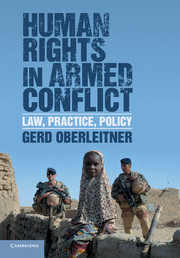Book contents
- Frontmatter
- Contents
- Acknowledgments
- Table of cases
- Table of Legal Instruments
- List of Abbreviations
- Introduction
- Part I Human rights in armed conflict: history of an idea
- Part II Human rights and humanitarian law: theory
- Part III Human rights and humanitarian law: challenges and commonalities
- Part IV The dynamics of war and law
- Part V Enforcement: practice and potential
- Conclusion
- Bibliography
- Index
Part II - Human rights and humanitarian law: theory
Published online by Cambridge University Press: 05 March 2015
- Frontmatter
- Contents
- Acknowledgments
- Table of cases
- Table of Legal Instruments
- List of Abbreviations
- Introduction
- Part I Human rights in armed conflict: history of an idea
- Part II Human rights and humanitarian law: theory
- Part III Human rights and humanitarian law: challenges and commonalities
- Part IV The dynamics of war and law
- Part V Enforcement: practice and potential
- Conclusion
- Bibliography
- Index
Summary
Human rights and humanitarian law: theory
With the adoption of the Universal Declaration of Human Rights in 1948 and the Geneva Conventions in 1949, the relationship between the emerging international human rights law and the law of armed conflict (now rebranded as international humanitarian law) had become a matter of interest. But right from the start, different theoretical conceptualizations of this relationship were put forward in the debate on the role of human rights in armed conflict and metaphorical rhetoric was mixed with legal analysis and policy considerations in attempts to clarify the interplay of human rights and humanitarian law. There was no shortage of concepts to this end; quite to the contrary: every contributor added a new nuance and soon, views ranged from the unquestioned primacy of humanitarian law and the subsequent complete exclusion of human rights from the theatre of war to various forms of concurrence and complementarity, only to be challenged by theories of integration and incorporation of human rights into humanitarian law and their cross-fertilization, up to a merger, fusion or even the identity of the two regimes. It seems there was hardly a theory which was not tested.
In order to retrospectively organize this debate, the various approaches to describing the relationship between human rights and humanitarian law will be grouped under three broad headings: exclusivity, complementarity and integration.
- Type
- Chapter
- Information
- Human Rights in Armed ConflictLaw, Practice, Policy, pp. 81 - 82Publisher: Cambridge University PressPrint publication year: 2015



